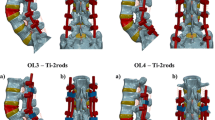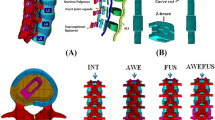Abstract
Study design
Finite element analysis.
Background data
Pedicle subtraction osteotomy (PSO) is associated with a high rate of mechanical complications and implant failures. The biomechanical reasons for these failures are unclear.
Objectives
Using finite element analysis (FEA): to analyze the biomechanical instability after a PSO, to compare the effect of constructs with different rod contours and analyze the mechanical forces acting on these constructs to explain the mechanisms of failure.
Methods
A 3D validated FE model of the spine from L1 to the sacrum was used. The model was modified to simulate a PSO of L4 in different situations: healthy, high dehydrated and completely degenerated discs. Loads were applied and range of motion (ROM) was measured. Pedicle screw constructs from L2 to S1 with different rod contours were added to the most instable scenario. Bending, torsion, shear moments and stress were measured.
Results
PSO alone had a moderate impact on the ROM of basic movements (flexion, extension and lateral bending). Secondary motion (torsion) in lateral bending increased 200 %. Greatest increase in ROM was observed with the PSO and degenerated discs. Secondary motion (torsion) in lateral bending increased +625 %. The instability after a PSO is rotational. Mean reduction of ROM was 95 % for all constructs tested. Rod contour affected the location of bending moments and stress. Sharp angle bend showed maximum bending moments (2,208 Nmm) and stress at the PSO level. Smooth contour of the rod showed maximum bending moments (1,940 Nmm) and stress at the sacral connection. Anterior support below the PSO reduced bending moments along the rod (−26 %).
Conclusion
The instability observed after a PSO is mainly rotational and increases with disc degeneration. Shape of rod contour affects the location of maximum stress in the constructs. These findings may explain different instrumentation failures.






Similar content being viewed by others
References
Daubs MD, Lenke LG, Cheh G et al (2007) Adult spinal deformity surgery: complications and outcomes in patients over age 60. Spine 32:2238–2244
Charosky S, Guigui P, Blamoutier A et al (2012) Complications and risk factors of primary adult scoliosis surgery. Spine 37:693–700
Bridwell KH, Lewis SJ, Edwards C et al (2003) Complications and outcomes of pedicle subtraction osteotomies for fixed sagittal imbalance. Spine 28:2093–2101
Bridwell KH, Lewis SJ, Lenke LG et al (2003) Pedicle subtraction osteotomy for the treatment of fixed sagittal imbalance. J Bone Jt Surg Am 85:454–463
Kim YJ, Bridwell KH, Lenke LG et al (2007) Results of lumbar pedicle subtraction osteotomies for fixed sagittal imbalance: a minimum 5 year follow-up study. Spine 32:2189–2197
Smith JS, Shaffrey CI, Ames CP et al (2012) Assessment of symptomatic rod fracture after posterior instrumented fusion for adult spinal deformity. Neurosurgery 71:862–868
Cho SK, Bridwell KH, Lenke LG et al (2012) Major complications in revision adult deformity surgery. Spine 32:2189–2197
Hyun SJ, Rhim SC (2010) Clinical outcomes and complications after pedicle subtraction osteotomy for fixed sagittal imbalance patients: a long term follow-up data. J Korean Neurosurg Soc 47:95–101
Berjano P, Bassani R, Casero A et al (2013) Failures and revisions in surgery for sagittal imbalance: analysis of factors influencing failure. Eur Spine J. doi:10.1007/s0586-013-3024-x
Tang JA, Leasure JM, Smith JS et al (2013) Effect of severity of rod contour on posterior rod failure in the setting of lumbar pedicle subtraction osteotomy: a biomechanical study. Neurosurgery 72:276–283
Scheer JK, Tang JA, Deviren V et al (2011) Biomechanical analysis of revision strategies for rod fracture in pedicle subtraction osteotomy. Neurosurgery 69:164–172
Cho KJ, Kim KT, Kim WJ et al (2013) Pedicle subtraction osteotomy in elderly patients with degenerative sagittal imbalance. Spine 38:E1561–E1566
Lavaste F, Skalli W, Robin S et al (1992) 3D geometrical and mechanical modelling of the lumbar spine. J Biomech 25(10):1153–1166
Skalli W, Robin S, Lavaste F et al (1993) 3D geometric and mechanical model of spinal fixation. Spine 18:536–545
Skalli W, Lavaste F, Barraco A et al (1982) Etude in vitro d’un segment vertébral lombaire humain. Comportement expérimental et modélisation mécanique. J Biophys Et Méd Nucl 6:193–199
Lecompte S, Goret E, Lavaste F et al (1987) Comportement mécanique du rachis lombaire en torsion. J Biophys Et Biomécanique 11:49–50
Marta Kurutz (2010). Finite element modelling of human lumbar spine, Finite Element Analysis. In: David Moratal (ed) ISBN: 978-953-307-123-7
Shirazi-Adl SA, Shrivastava SC, Ahmed AM (1984) Stress analysis of the lumbar discbody unit in compression. A three-dimensional nonlinear finite element study. Spine 9(2):120–134
Fagan MJ, Julian S, Siddall DJ, Mohsen AM (2002) Patient specific spine models. Part 1: finite element analysis of the lumbar intervertebral disc—a material sensitivity study. In: Proceedings of the Institution of Mechanical Engineers, Part H: 216(5), 299–314
Goel VK, Gilbertson LG (1995) Applications of the finite element method to thoracolumbar spinal research—past, present and future. Spine 20(15):1719–1727
Chen CS, Cheng CK, Liu CL, Lo WH (2001) Stress analysis of the disc adjacent to interbody fusion in lumbar spine. Med Eng Phys 23(7):483–491
Zhong ZC, Wei SH, Wang JP, Feng CK, Chen CS, Yu CH (2006) Finite element analysis of the lumbar spine with a new cage using a topology optimization method. Med Eng Phys 28(1):90–98
Roy-Camille R, Lavaste F, Mazel C et al (1987) Etude expérimentale tridimensionnelle des déplacements d’une ou de plusieurs unités vertébrales. Présentation d’un banc de mesure. Rev Chir Orthop Suppl II 73:237–240
Lavaste F, Asselinenau A, Diop A et al (1990) Protocole expérimentale pour la caractérisation mécanique de segments rachidiens et de matériel d’ostéosynthèse dorso-lombaire. Rachis 2:435–446
Shirazi-adl A, Ahmed M, Shirvastava SC (1986) A finite element study of a lumbar motion segment subjected to pure sagittal plane moments. J Biomech 19-4:331–350
Shultz AB, Warwick DM, Beekson MH (1979) Mechanical properties of human lumbar spine motion segments Part I: response in flexion, extension, lateral bending and torsion. J Biomech Eng 101:46–52
Robin S (1992) Modélisation biomécanique de la colonne vertébrale lombaire. Thèse de doctorat. Paris. ENSAM 1992. N° OCLC 490378315
Panjabi MM, White AA (1990) Physical properties and functional biomechanics of the spine. In: White AA, Panjabi MM (eds) Clinical biomechanics of the spine. Philadelphia, J. B. Lippincott, pp 1–84
Conflict of interest
None.
Author information
Authors and Affiliations
Corresponding author
Rights and permissions
About this article
Cite this article
Charosky, S., Moreno, P. & Maxy, P. Instability and instrumentation failures after a PSO: a finite element analysis. Eur Spine J 23, 2340–2349 (2014). https://doi.org/10.1007/s00586-014-3295-x
Received:
Revised:
Accepted:
Published:
Issue Date:
DOI: https://doi.org/10.1007/s00586-014-3295-x




